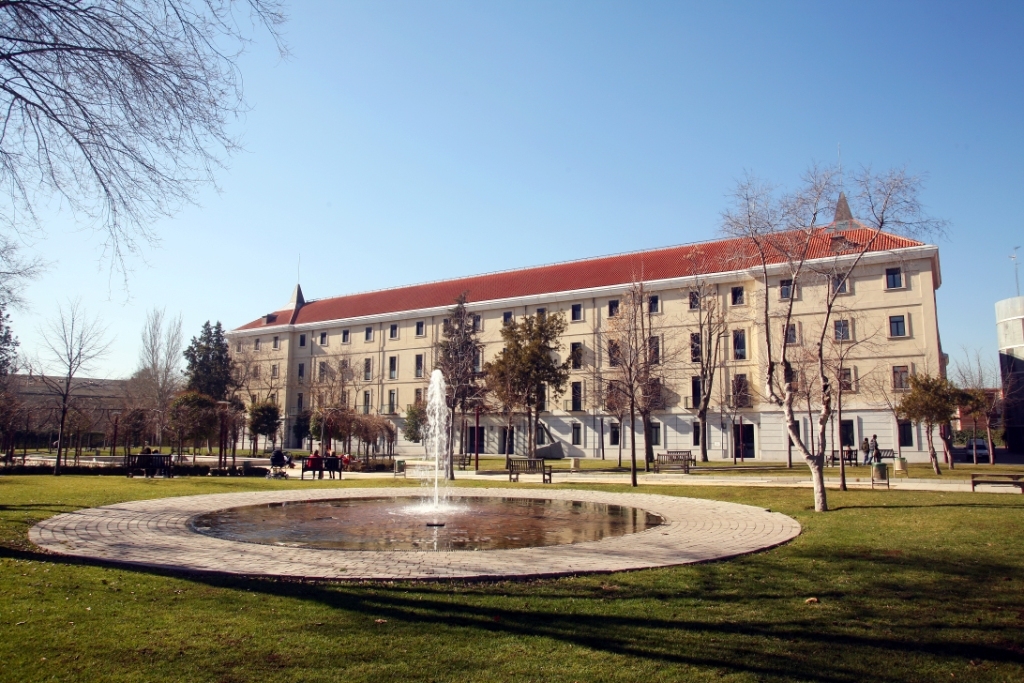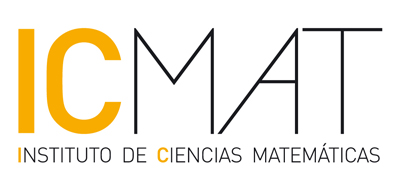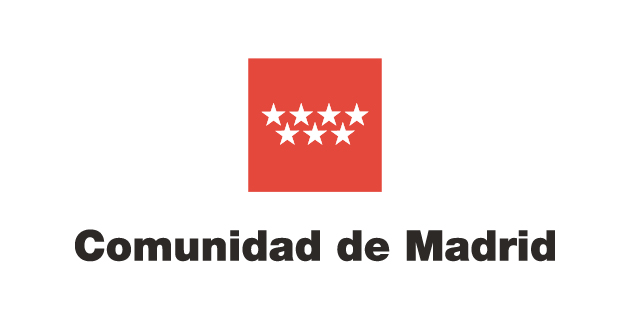
IX International Workshop on Information Geometry, Quantum Mechanics and Applications 2025
24 - 28 February 2025
Universidad Carlos III
Daniele Amato.
Open-quantum-system asymptotic evolution: algebraic structure and the role of complete positivity
In this talk, we will discuss the algebraic features of the asymptotic evolution of open quantum systems in the Heisenberg picture. In particular, we will overview the algebraic structure of the attractor subspace and of the asymptotic dynamics. Also, we will analyze the decoherence-free algebra and its recently proposed variant, which alternatively describes the asymptotic subspace of the evolution. Finally, we will see how complete positivity is not necessary in order to prove these findings. Indeed, the validity of the operator Schwarz inequality turns out to be sufficient for the description of the asymptotics. Joint work with Paolo Facchi (UNIBA & INFN) and Arturo Konderak (CFT-Warsaw).
Giuliano Angelone.
Isospectrality of generalized Dirac combs
In this talk I will discuss the isospectrality problem for generalized Dirac combs, a family of Hamiltonians describing a spinless one-dimensional particle moving in an infinite and periodic array of generalized point interactions, the latter being the most general singular perturbation, localized in a point, of the kinetic energy operator. In particular, I will explicitly determine which generalized Dirac combs are isospectral (and, moreover, unitarily equivalent) and which are instead univocally associated with their energy spectrum, and can be thus 'heard'.
Marco Castrillón.
Reduction, unreduction and singular lagrangians
The theory of singular Hamiltonian reduction in Mechanics is a wel stablished construction strongly based on the momentum map. When one wants to understand the analog in the Lagrangian framework, the contribution in the literature are much poorer. The goal of this contributon is the exploration of this issue with two different techniques (unreduction an blow-ups), including more questions that real final results.
Goffredo Chirco.
SO(2,2) extension of JT gravity via the Virasoro-Kac-Moody semidirect product
We consider a bulk plus boundary extension of Jackiw-Teitelboim Gravity (JT) realised via a SO(2,2) Poisson Sigma Model. We discuss the role of boundary conditions in relation to the symmetries of the boundary dynamics and we show that the boundary action can be written in terms of coadjoint orbits of an appropriate Virasoro-Kac-Moody group, which reduces to a Schwarzian action plus additional Kac-Moody edge modes dynamics.
Fernando Ezquerro.
Casimir energy in lattice gauge theories
In this talk we show a non-perturbative computation of the Casimir energy for gauge theories by using Lattice Monte Carlo simulations, and compare with the expected exponential decay in the Casimir energy of a massive scalar field.
Paolo Facchi.
Non-Markovian dynamics of the generation of bound states in the continuum
The excitation of bound states in the continuum (BICs) in multi-qubit systems lies at the heart of entanglement generation and harnessing in waveguide quantum electrodynamics platforms. We prove that scattering of a parity-invariant single photon on a qubit pair, combined with a properly engineered time variation of the qubit detuning, is not only feasible, but also more effective than strategies based on the relaxation of the excited states of the qubits. The use of tensor network methods to simulate the proposed scheme enables to include photon delays in collision models, thus opening the possibility to follow the time evolution of the full quantum system, including qubits and field, and to efficiently implement and characterize the dynamics in non-ideal cases, which turn out to be optimal for the BIC generation strategy.
Tobias Fritz.
Categories and Probability Theory
TBD
Paolo Gibilisco.
Popper mathematician
Due to needs of his view of the logic of scientific discovery Popper was induced to propose a new axiomatization of the notion of conditional probability. As a by-product of his approach he was able to give a new characterization of Boolean algebras in terms of above mentioned conditional probability. This very particular mathematical result is not very well known: the purpose of my talk is to give it the attention it deserves.
Sara Giordano.
Quantum Algorithm for Testing Graph Completeness
Testing graph completeness is a critical problem in computer science and network theory. Leveraging quantum computation, we present an efficient algorithm using the Szegedy quantum walk and quantum phase estimation (QPE). Our algorithm, which takes the number of nodes and the adjacency matrix as input, constructs a quantum walk operator and applies QPE to estimate its eigenvalues. These eigenvalues reveal the graph's structural properties, enabling us to determine its completeness. We establish a relationship between the number of nodes in a complete graph and the number of marked nodes, optimizing the success probability and running time. The time complexity of our algorithm is O(log2n), where n is the number of nodes of the graph. offering a clear quantum advantage over classical methods. This approach is useful in network structure analysis, evaluating classical routing algorithms, and assessing systems based on pairwise comparisons.
Giovanni Gramegna.
Relative volume of comparable pairs under semigroup majorization
In several quantum resource theories, state conversions are governed by a majorization relation between probability vectors. After discovering this connection for the resource theory of entanglement, Nielsen conjectured that as the system dimensionality increases, the fraction of convertible pairs of states vanishes. This conjecture was analytically proven only recently for the resource theory of entanglement [1], following systematic numerical investigations [2]. For the resource theory of coherence a proof was found in [3]. However, in both cases, it remains unclear how quickly the fraction of convertible pairs decays.The conjecture can be extended to the resource theory of thermal operations, where state conversions are governed by a generalized majorization relation. In this case, we prove [4] the conjecture in the limit of low temperature, and provide an explicit expression for the fraction of convertible pairs, valid at any dimension. Furthermore, we consider situations where exact conversion is not achievable, and compute explicitly the distribution of the maximal success probability between random initial and target states.
[1] Jain V., Kwan M., Michelen M. (2024). Entangled states are typically incomparable. arXiv:2406.03335.
[2] Cunden F. D., Facchi P., Florio G., Gramegna G. (2020). Volume of the set of LOCC-convertible quantum states. Journal of Physics A: Mathematical and Theoretical, 53(17), 175303.
[3] Cunden F. D., Facchi P., Florio G., Gramegna G. (2021). Generic aspects of the resource theory of quantum coherence. Physical Review A, 103(2), 022401.
[4] Cunden F. D., Czartowski J., Gramegna G. , De Oliveira Junior A. (2024). Relative volume of comparable pairs under semigroup majorization, arXiv preprint arXiv:2410.23196
Alioscia Hamma.
Entanglement and Stabilizer Entropies - what makes a quantum system complex?
We all know that entanglement is important in quantum mechanics. However, every form of complex behavior, including that which is responsible for quantum advantage, needs a second ingredient, colloquially known as magic. In this talk we will show that quantum advantage and quantum complexity arise from the conspiracy and interplay of two entropic resources, Entanglement Entropy (EE) and Stabilizer Entropy (SE). In particular, quantum complex behavior arises when stabilizer entropy gets scrambled around. We will provide an introduction to the resource theory of SE and applications in quantum many-body systems, quantum metrology, black-hole physics, and foundations of quantum mechanics.
Davide Lonigro.
Quantum particle in the wrong box (or: the perils of finite-dimensional approximations)
When numerically simulating the unitary time evolution of an infinite-dimensional quantum system, one is usually lead to treat the Hamiltonian $H$ as an “infinite-dimensional matrix” by expressing it in some orthonormal basis of the Hilbert space, and then truncate it to some finite dimensions. However, the solutions of the Schrödinger equations generated by the truncated Hamiltonians need not converge, in general, to the solution of the Schrödinger equation corresponding to the actual Hamiltonian. In fact, here we demonstrate that they converge to the solution of the Schrödinger equation generated by a specific operator which crucially depends on the particular choice of basis—and, importantly, is generally different from $H$ itself. When this happens, numerical simulations will unavoidably reproduce the wrong dynamics in the limit, and yet there is no numerical test that can reveal this failure, unless one has the analytical solution to compare with.
As a practical demonstration of such results, we consider the quantum particle in the box, and we show that, for a wide class of bases—which include associated Legendre polynomials as a concrete example—the dynamics generated by the truncated Hamiltonians will always converge to the one corresponding to the particle with Dirichlet boundary conditions, regardless the desired choice of boundary conditions. Other such examples are discussed.
Based on arXiv:2412.15889, joint work with with F. Fischer and D. Burgarth.
Marco Pacelli.
The inverse problem in Information Geometry: Insights and Perspectives
The geometric content of a statistical manifold in the sense of Lauritzen is given by a pseudo-Riemannian metric and a pair of torsion-free affine connections related by a compatibility condition. Recently, a generalised version of such manifolds has been studied, where the compatibility condition still holds, but torsion is allowed for both connections. In the standard statistical setting, Eguchi showed that the metric and connections can be encoded by a divergence function. This naturally leads to the inverse problem: given a manifold with a metric and a compatible pair of torsion-free affine connections, does a divergence function generate them? Matumoto provided a positive answer from a theoretical perspective, while Ay and Amari proposed a solution with practical relevance. In the generalised setting, we propose an extension of contrast functions to a new geometric object, which we call contrast bi-forms. Then, we discuss some aspects of the inverse problem in this framework, drawing parallels with the standard case.
Paolo Perrone.
Categorical Probability with Additional Geometry
In probability, information theory and quantum foundations, geometry and geometric intuition has always been a very helpful tool. Lately, these subjects have benefited from a category-theoretic formulation. It is therefore desirable to incorporate these geometric notions into the language of category theory, and the good news is that this is both possible and fruitful. In this talk, we will see how.
- The first way to incorporate geometry into categories is via an enrichment. As a case example, we show how to metrically enrich Markov categories, and recover some traditional ideas of information theory.
- Another way to encode geometry in a category is via a dagger or star structure, which can be interpreted as a 'notion of orthogonality'. As case examples, we present the category of couplings (in classical probability) and of Hilbert spaces (in quantum information), and show the role of projectors in both situations (conditional expectations in the classical case, measurements in the quantum case).
- Finally, we combine the two approaches, to obtain topologically enriched dagger categories. As an example, we show how a cornerstone result of probability, the martingale convergence theorem, can be formulated and proven completely in these categorical and geometrical terms.
Relevant papers and preprints:- P. Perrone, Markov Categories and Entropy, IEEE Transactions of Information Theory 70(3), 2024 (arXiv:2212.11719)
- N. Ensarguet and P. Perrone, Categorical Probability Spaces, Ergodic Decompositions, and Transitions to Equilibrium, submitted (arXiv:2310.04267)
- P. Perrone and R. Van Belle, Convergence of Martingales via Enriched Dagger Categories, submitted (arXiv:2404.15191)
Hayato Saigo.
From Categories to Quantum Fields: Category algebras and States on Cateogries
Historically, quantum field theory emerged as a unification of relativity and quantum mechanics. The former can be seen as a categorical structure, and the latter as a noncommutative probability structure. In this talk, we will introduce an attempt at quantum field theory based on the concept of 'category algebras', which are convolution algebras defined on categories as spacetime, and 'states on categories', which are positive unital linear functionals on them.
Urs Schreiber.
Quantum Processes and Linear Homotopy Types
I'll survey how (dependent, linear) homotopy types serve as a powerful foundation for formulating quantum information-theoretic processes (cf. ncatlab.org/schreiber/show/Quantum+Certification+via+Linear+Homotopy+Types).
Kornikar Sen.
Energy extraction from quantum batteries and the role of entanglement
Energy extraction from quantum batteries by means of completely positive trace-preserving (CPTP) maps leads to the concept of CPTP-local passive states, which identify bipartite states from which no energy can be squeezed out by applying any CPTP map to a particular subsystem. We prove, for arbitrary dimension, that if a state is CPTP-local passive with respect to a Hamiltonian, then an arbitrary number of copies of the same state—including an asymptotically large one—is also CPTP-local passive. We show further that energy can be extracted efficiently from CPTP-local passive states employing noncompletely positive trace-preserving (NCPTP) but still physically realizable maps on the same part of the shared battery on which operation of CPTP maps were useless. Moreover, we provide the maximum extractable energy using local-CPTP operations, and then, we present an explicit class of states and corresponding Hamiltonians, for which the maximum can be outperformed using physical local NCPTP maps. We provide a necessary and sufficient condition and a separate necessary condition for an arbitrary bipartite state to be unable to supply any energy using NCPTP operations on one party with respect to an arbitrary but fixed Hamiltonian. We build an analogy between the relative status of CPTP and NCPTP operations for energy extraction in quantum batteries, and the association of distillable entanglement with entanglement cost for asymptotic local manipulations of entanglement. The surpassing of the maximum energy extractable by NCPTP maps for CPTP-passive as well as for CPTP-nonpassive battery states can act as detectors of non-CPTPness of quantum maps.
Vito Viesti.
Stability of quantum symmetries against perturbations
A privileged role in the description of a quantum system is played by symmetries, which are operators that remain constant in time (in the Heisenberg picture). Quantum symmetries can be further classified based on their stability with respect to perturbations of the Hamiltonian. There are robust symmetries, which, despite the perturbation, stay close to their initial values throughout the evolution. On the other hand, fragile symmetries accumulate significant deviations from their initial values over time due to the perturbation. Our goal is to provide a precise characterization of both robust and fragile symmetries against particular sets of perturbations.



